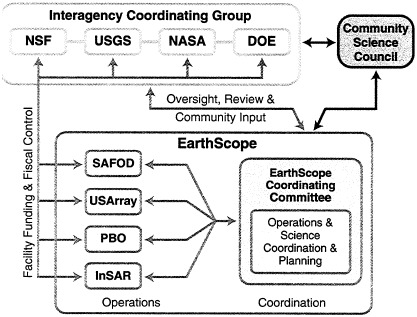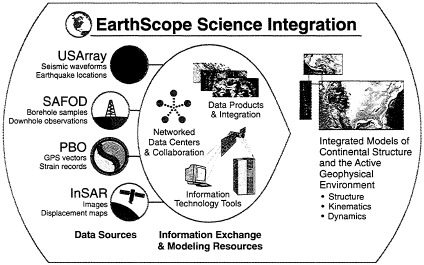3
Implementation and Management
EarthScope is a complex endeavor that will require a coherent management scheme that emphasizes integration across its many aspects. The EarthScope Working Group pointed out that EarthScope will require management and coordination at several intersecting levels:
-
As a facilities program—the various components of EarthScope will need to build on the strengths of the individual communities that they represent, but be undertaken in a manner that closely coordinates decision making and implementation during all phases of development—project planning, instrument definition, site selection, data collection, data management, and project review.
-
As a scientific endeavor—the breadth of EarthScope’s disciplinary and geographic reach will influence many aspects of earth science research in the United States for the next decade and beyond. There must be close coordination among the facilities, their management, the user community, and funding agencies.1
The challenge to have an effective, integrated management structure applies both to the implementation and operations of the facilities program, and to the scientific and educational endeavors that are based on the data and information acquired. In planning the management, coordination, and advisory studies of both aspects of EarthScope, incentives and strategies to ensure and encourage inte-
gration must be incorporated at the earliest stages and continually reinforced. In supporting EarthScope science, those making decisions on funding will have to recognize a wide spectrum of contributions from disciplines and activities both inside and outside the confines of the institutional earth science budgeting process. Innovation and creativity in both management and funding should match the innovation and creativity of the program goals. The overall management scheme for EarthScope will require a number of elements. These include effective mechanisms for integrating component parts of the program, for soliciting advice on science directions, for making effective decisions enabling rapid response to selected opportunities, and for accomplishing educational and outreach activities.
The current proposal of the EarthScope Working Group for a management structure has several components (Figure 5). Interagency coordination is to be accomplished by the Interagency Coordinating Group. An EarthScope Coordinating Committee is proposed to perform the “day-to-day” oversight and planning, and a Community Science Council will provide high-level advice to the agencies and coordination for the overall program. This design for the management structure is little more than a “cartoon” in the documentation available to the committee and begs questions about how it will work. Will the EarthScope Coordinating Committee have a high-level role in resource allocation and setting science priorities, or will this be undertaken only by interaction between the Interagency Coordinating Group and the individual EarthScope facility management teams (Figure 5)? The effective functioning of the EarthScope management structure, to achieve the required integration, will depend on details still to be developed. From presentations made to the committee, it is clear that members of the science community and the NSF staff have devoted a good deal of thought to the issue. It is critically important that this activity continue to ensure the evolution of a structure that will achieve the ambitious program goals.
Although it is clear that the community is aware of the challenges of managing an earth science program of this unprecedented scope, individual components of the EarthScope enterprise will also require innovative management. For example, new ways to integrate large and complex data streams to elucidate dynamic earth phenomena will be needed. One example of an innovative approach for integrating data streams involves establishing a “Community Modeling Environ-

Figure 5. Proposed structure for oversight and management of EarthScope facilities (from EarthScope Working Group, 2001; EarthScope— A New View into Earth).
ment” (Figure 6), an idea that stems from a workshop2 convened by IRIS (Incorporated Research Institutions in Seismology). The committee encourages continued exploration of innovative structures to stimulate and provide for integration. In a similar vein, the committee encourages exploration of ways to optimize the education and outreach efforts of EarthScope.
In conclusion, the committee stresses that management and coordination must be highly effective at several levels, and furthermore, that careful attention must be paid to the selection of an overall structure and its component parts as EarthScope moves toward implementation. In particular, the scientific advisory structure must encompass all elements

Figure 6. Schematic showing coordinated and integrated data management structure for all EarthScope elements (from EarthScope Working Group, 2001; EarthScope—A New View into Earth).
of EarthScope to provide oversight and advice on the scientific directions of the program. The committee believes that the advisory structure also should include liaisons to other programs that can complement or extend EarthScope (discussed in next chapter).




